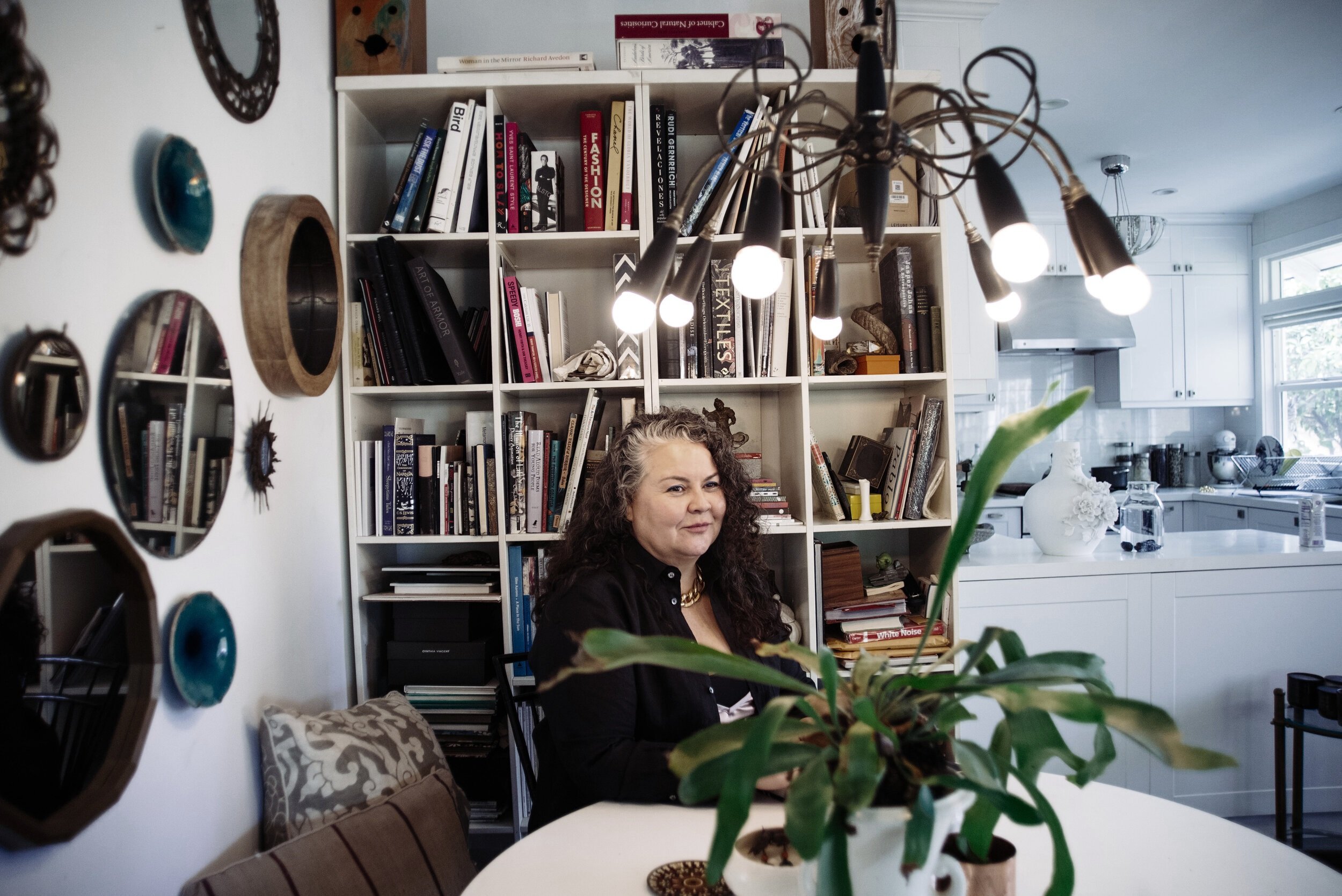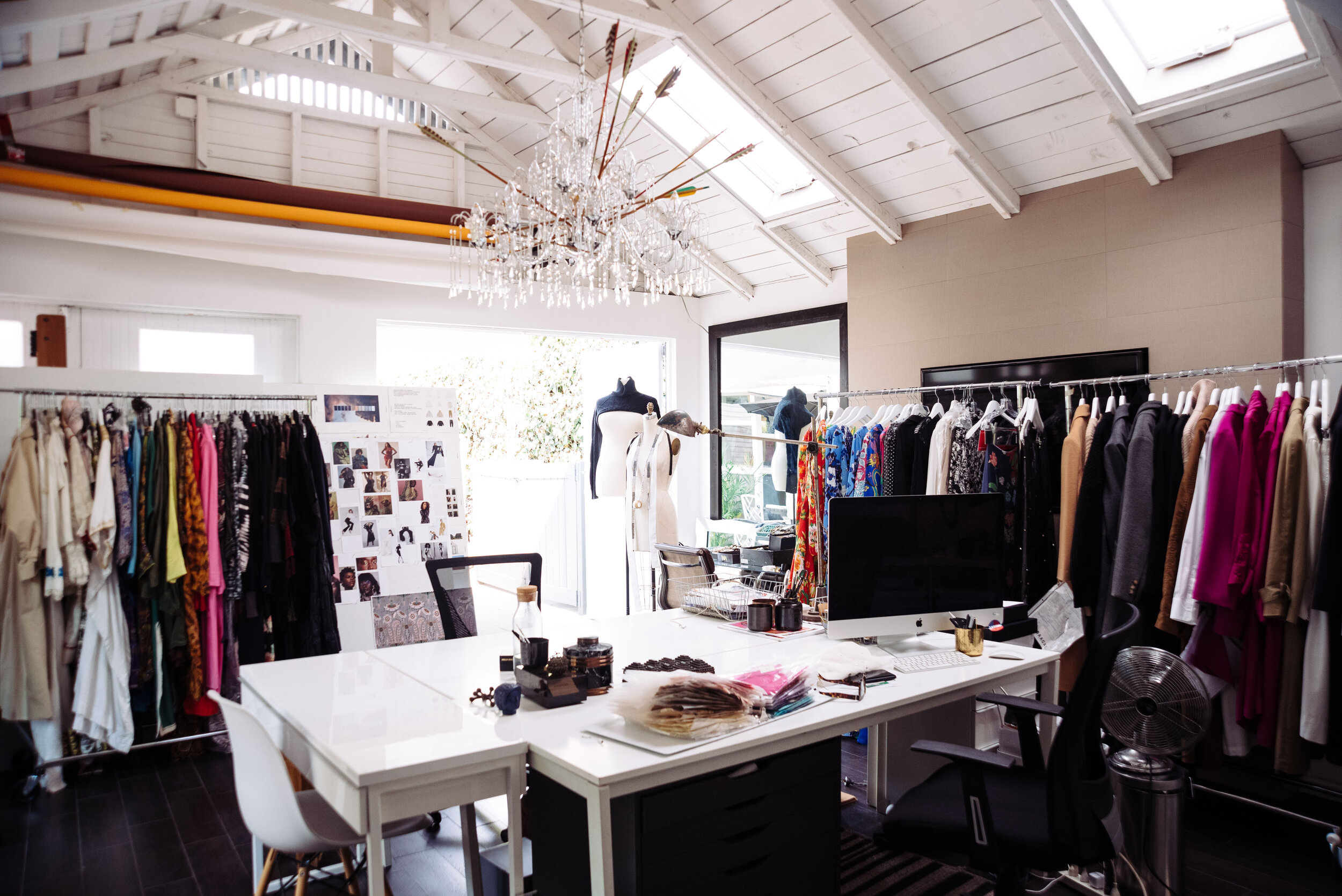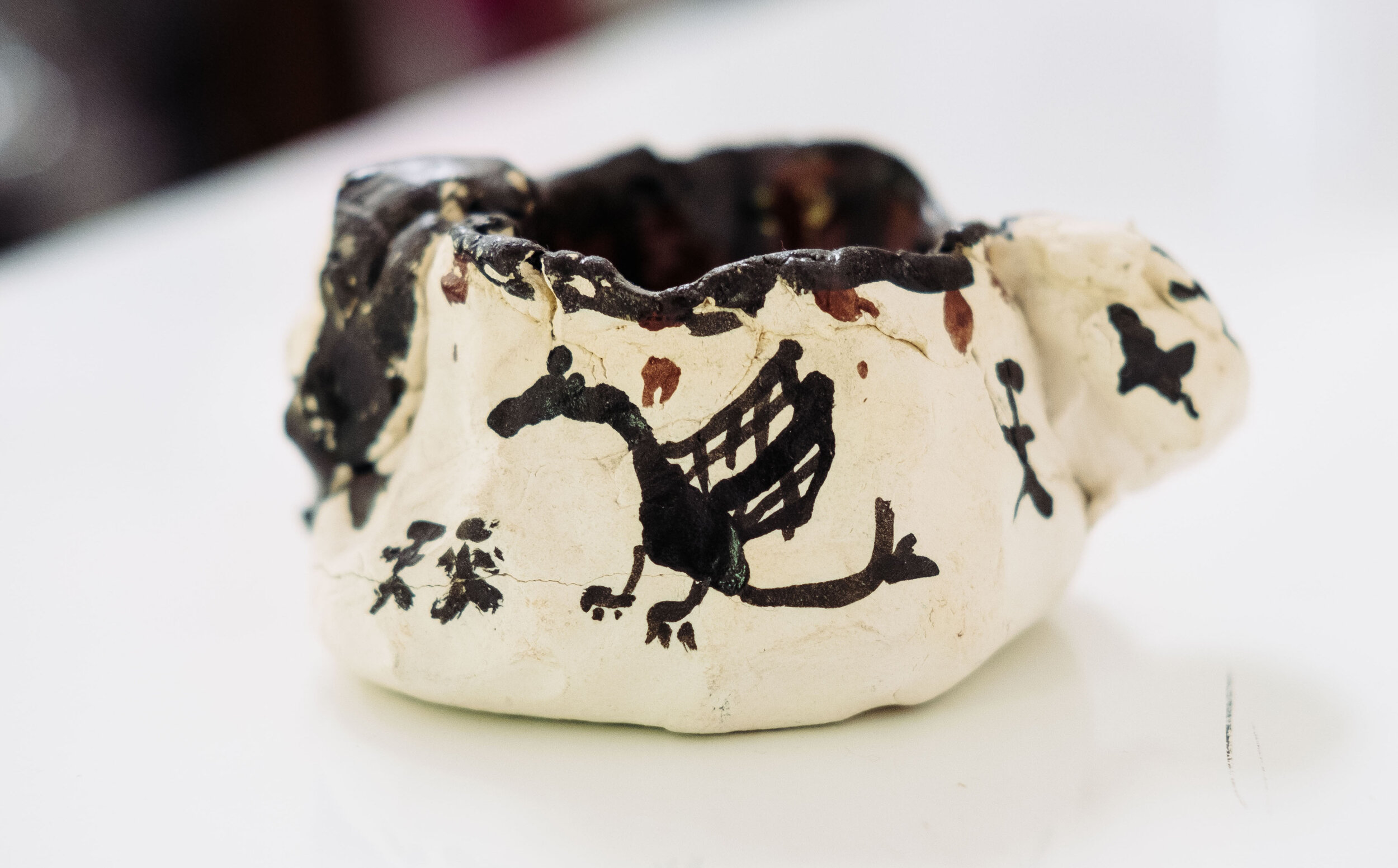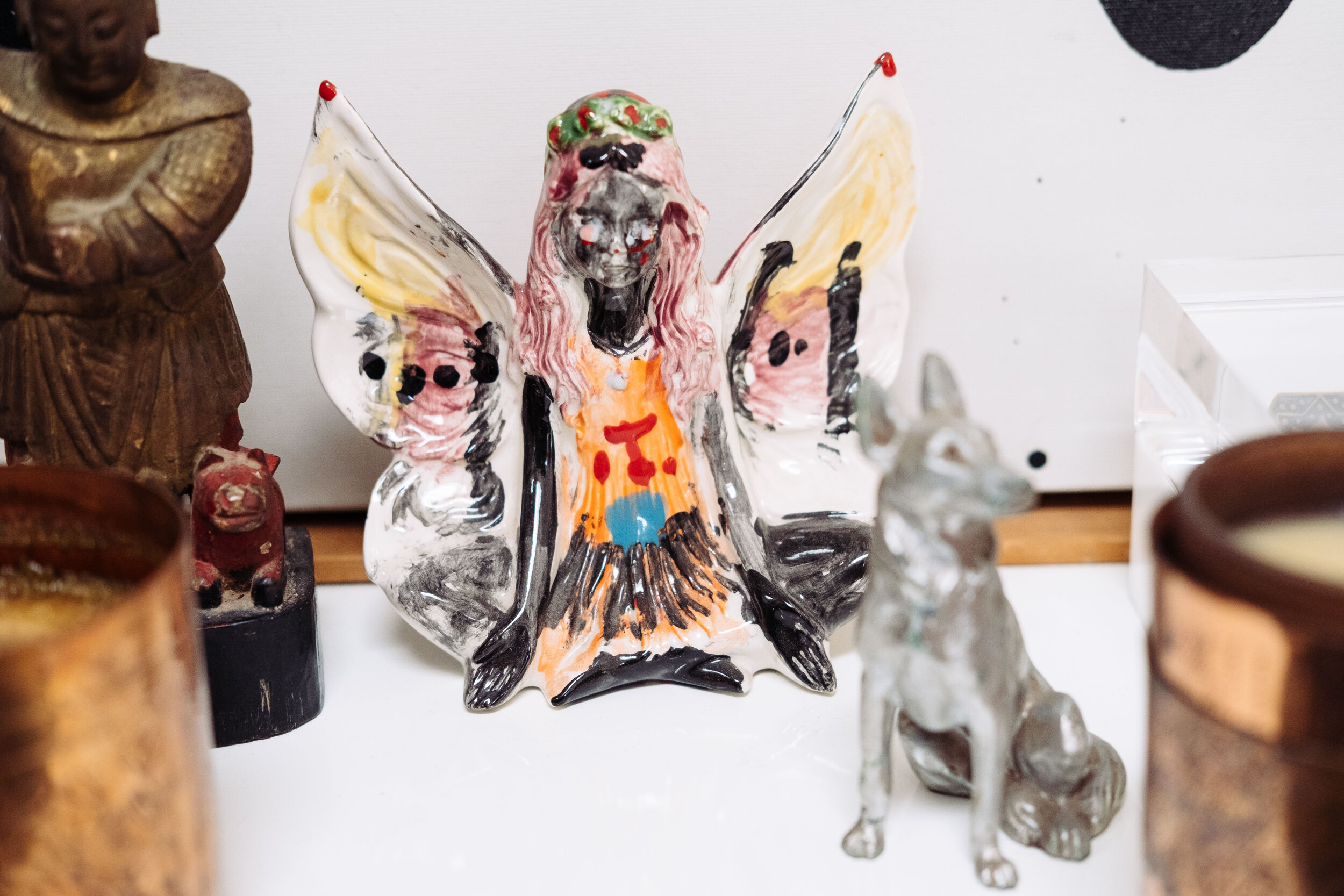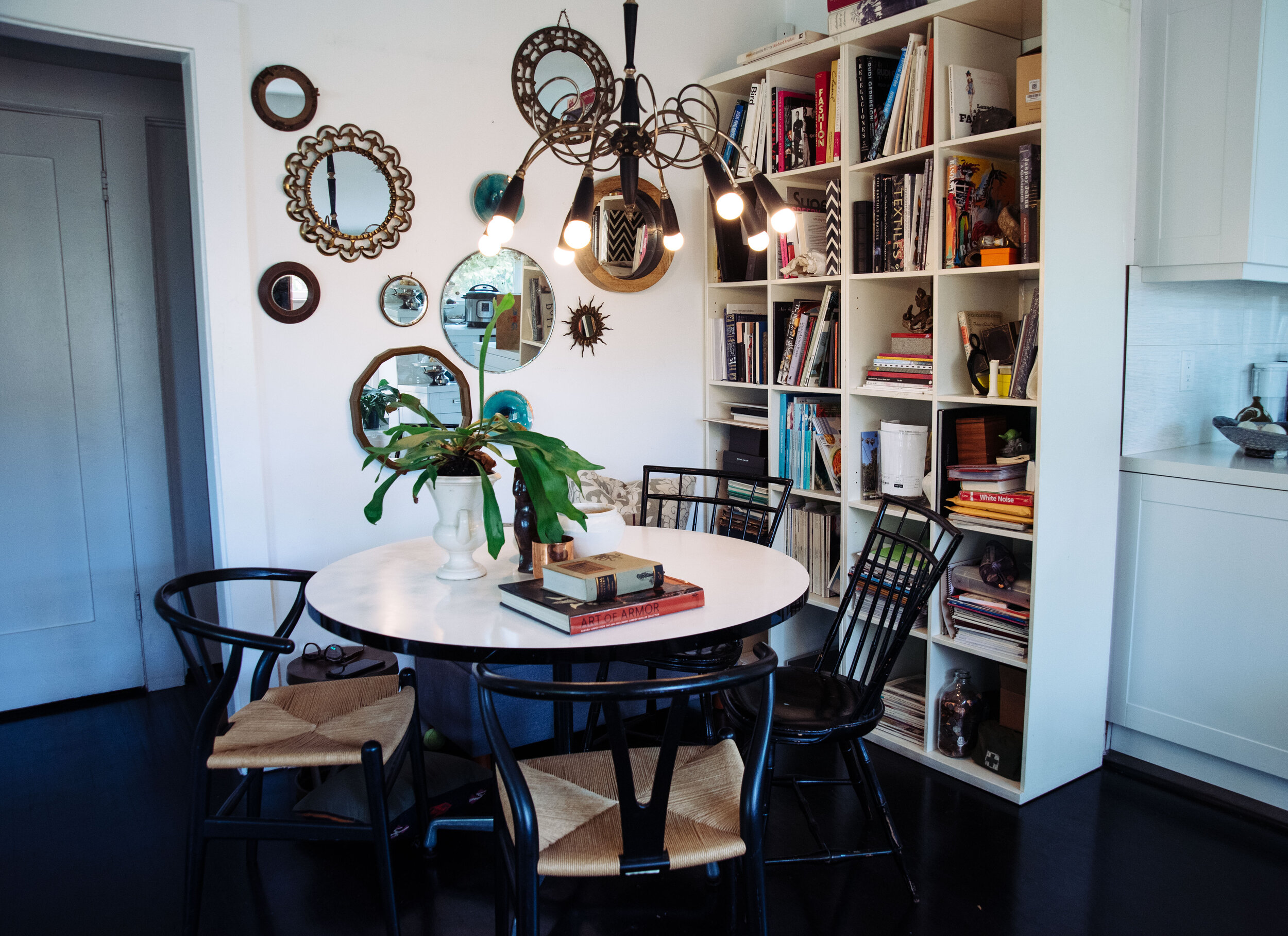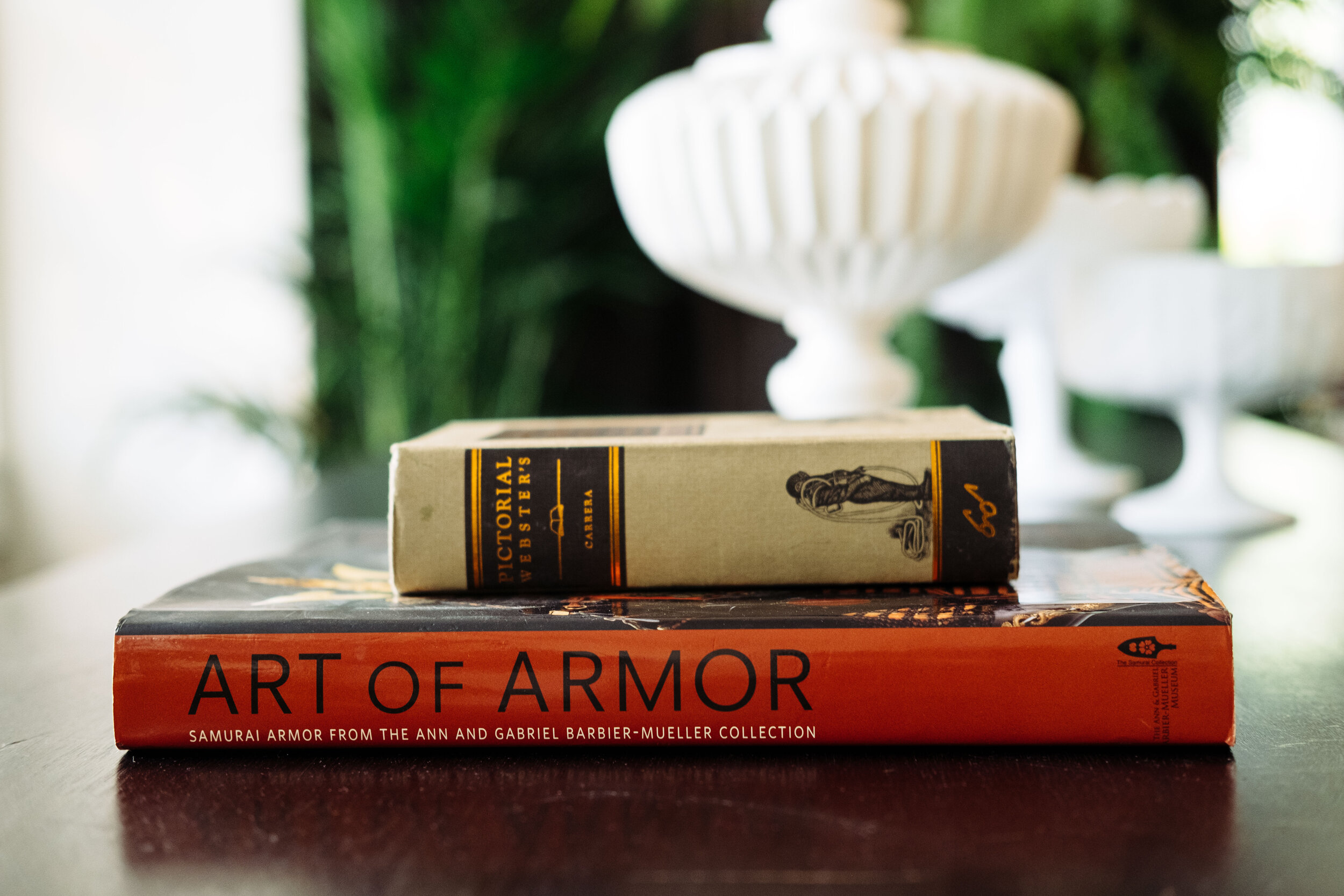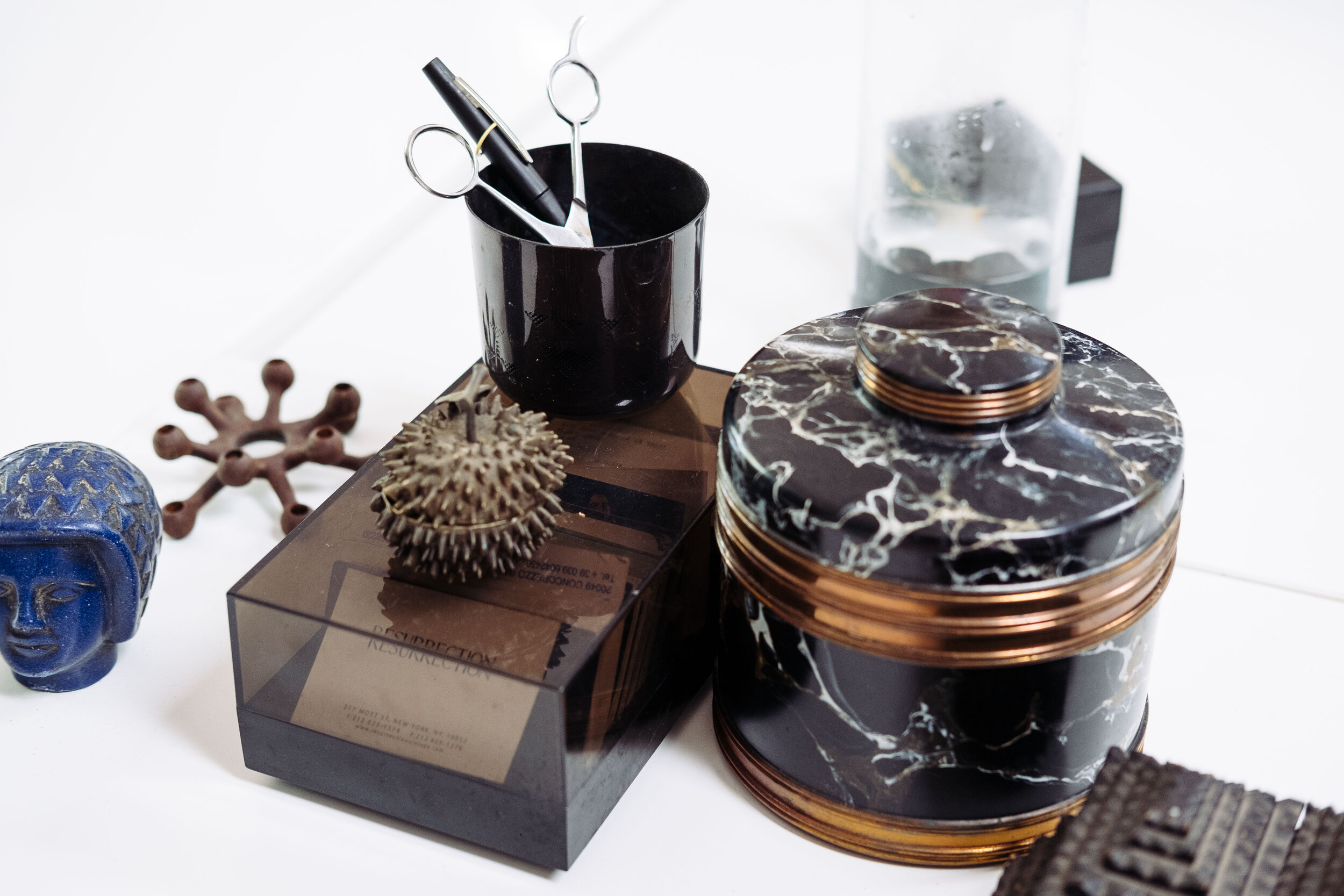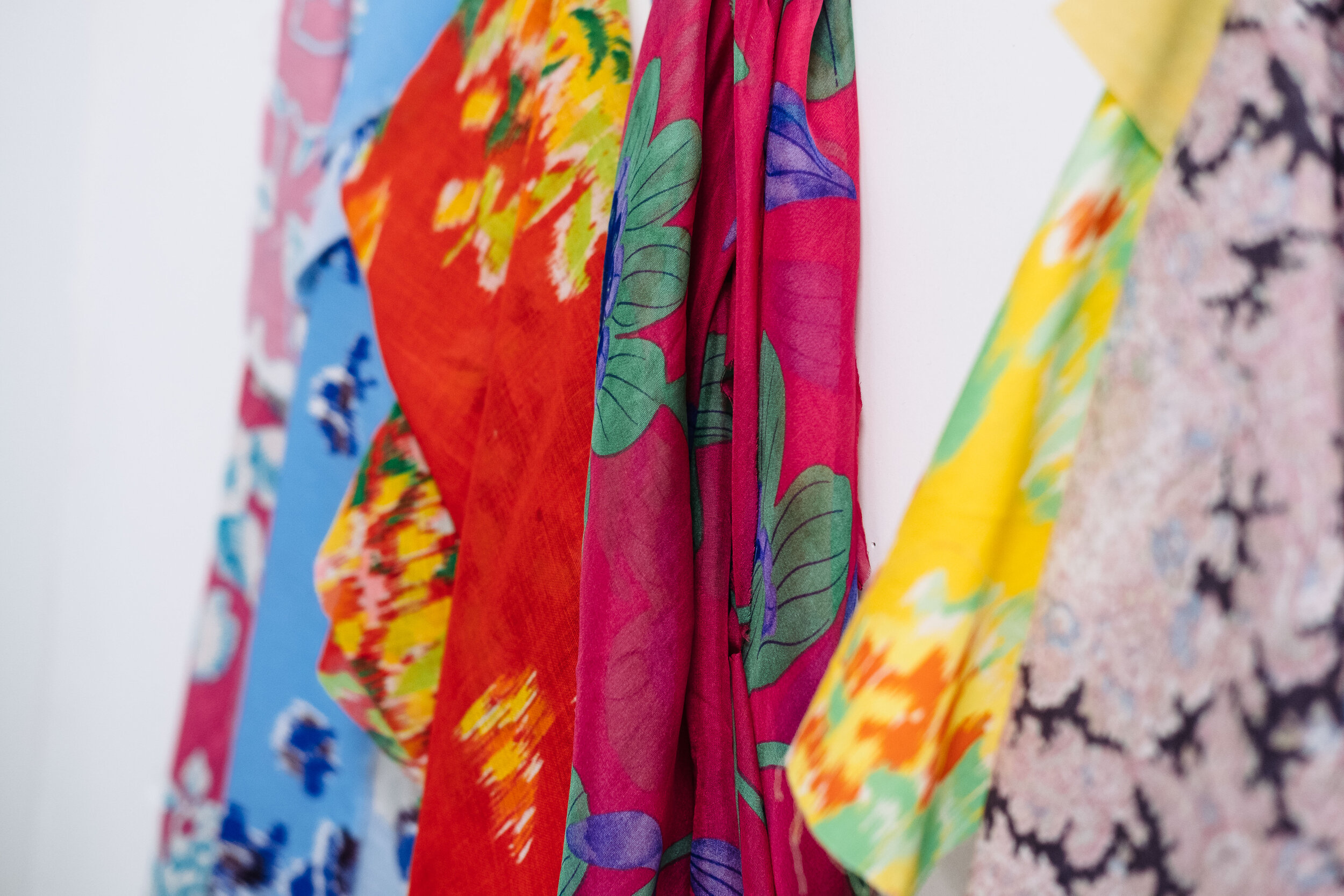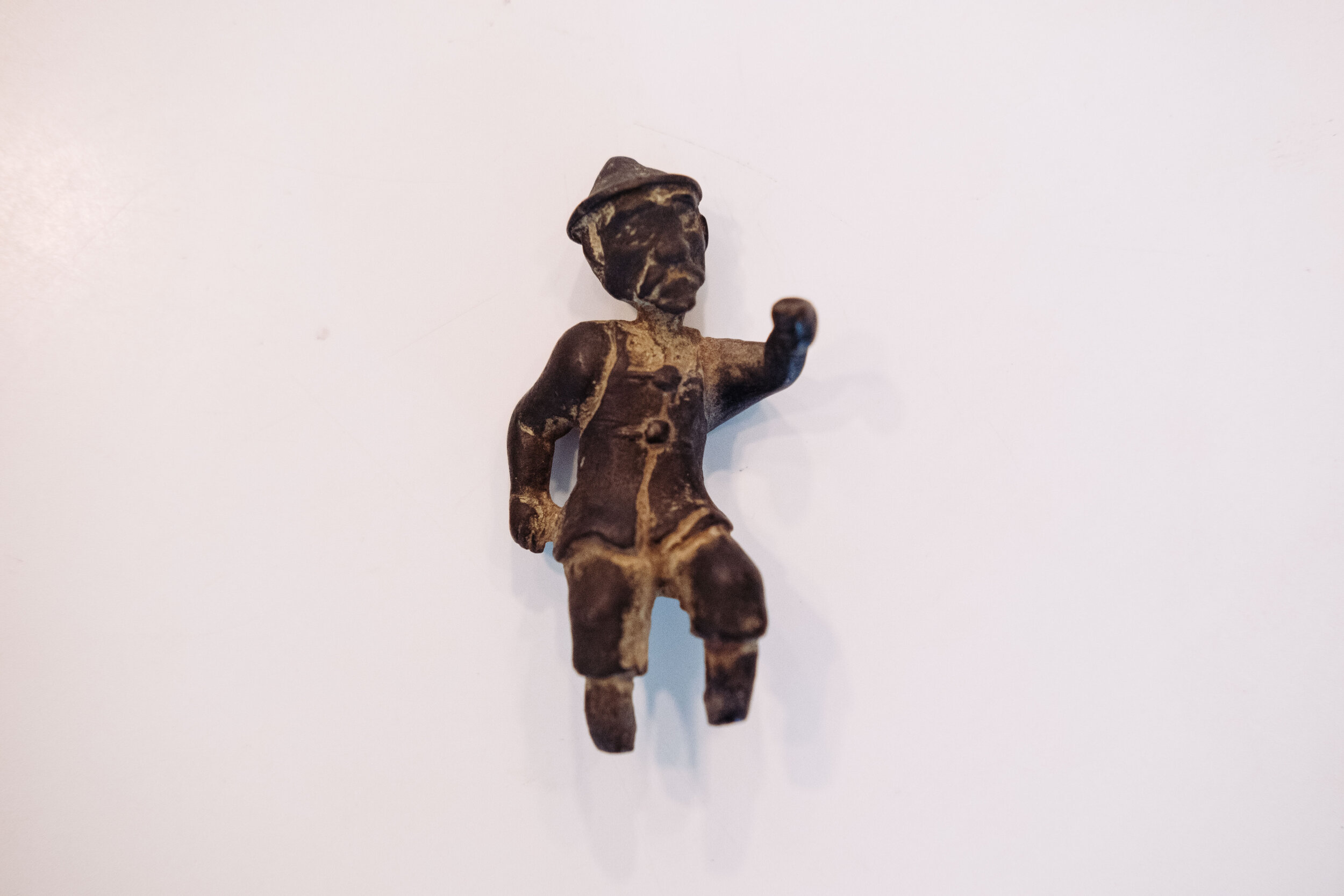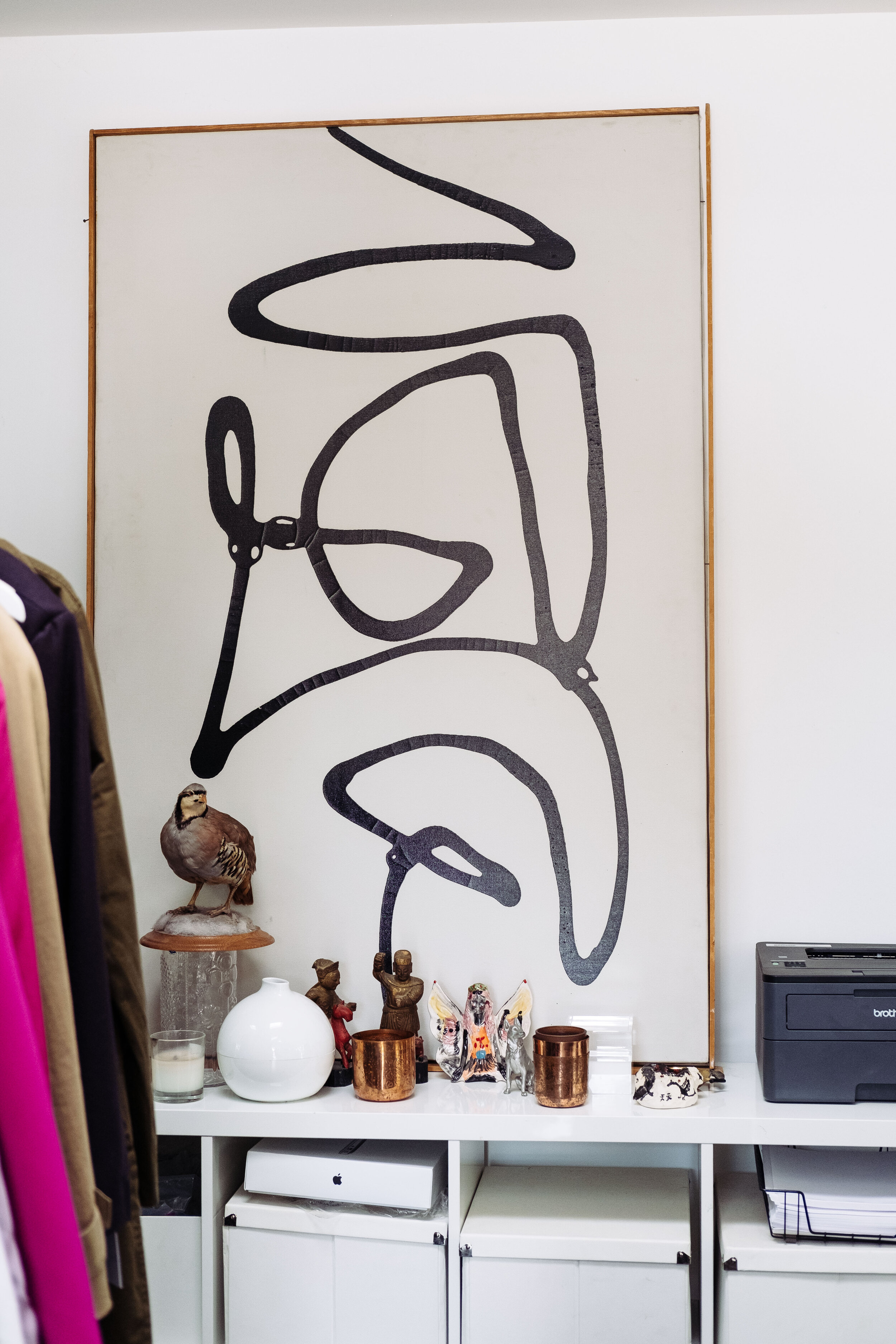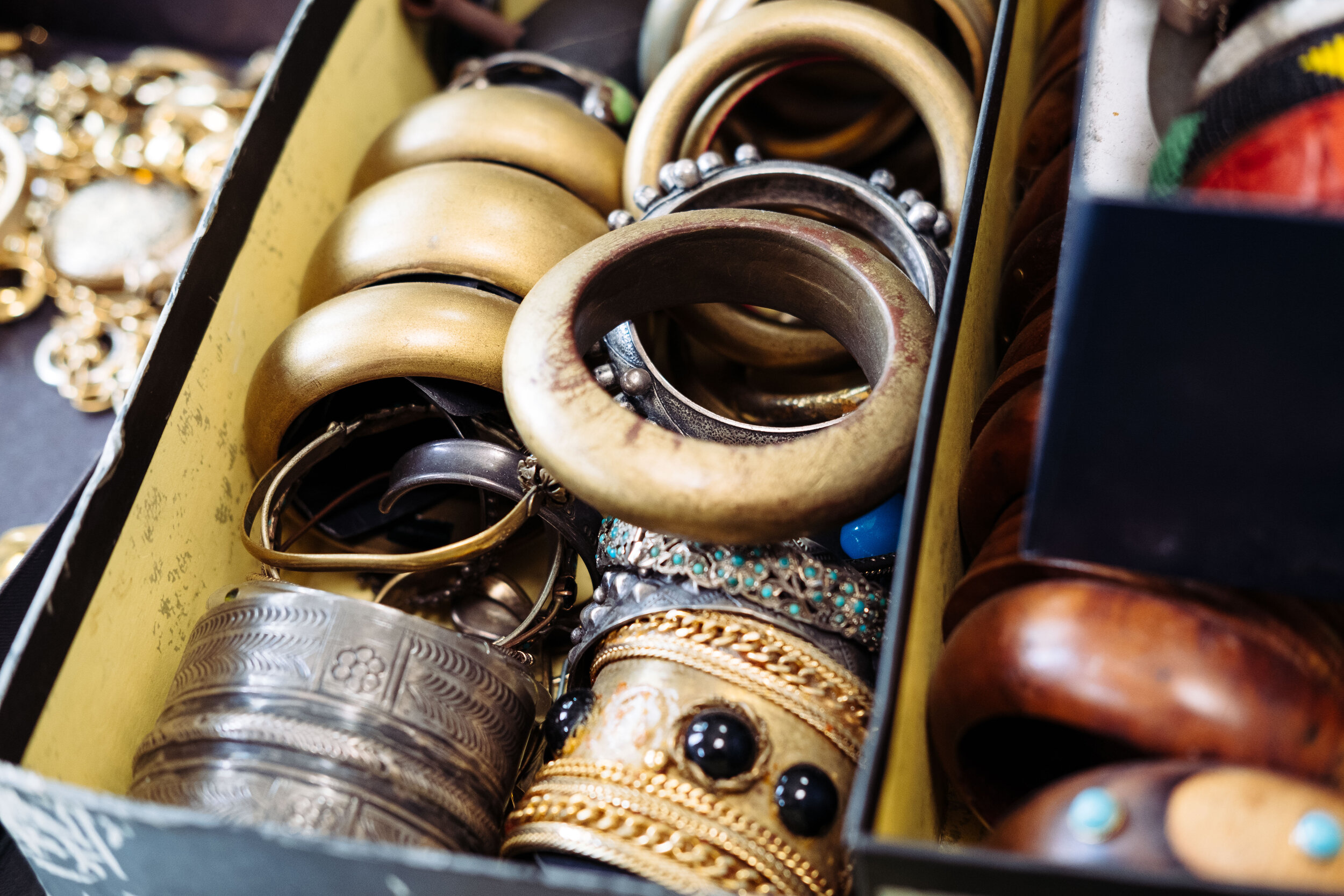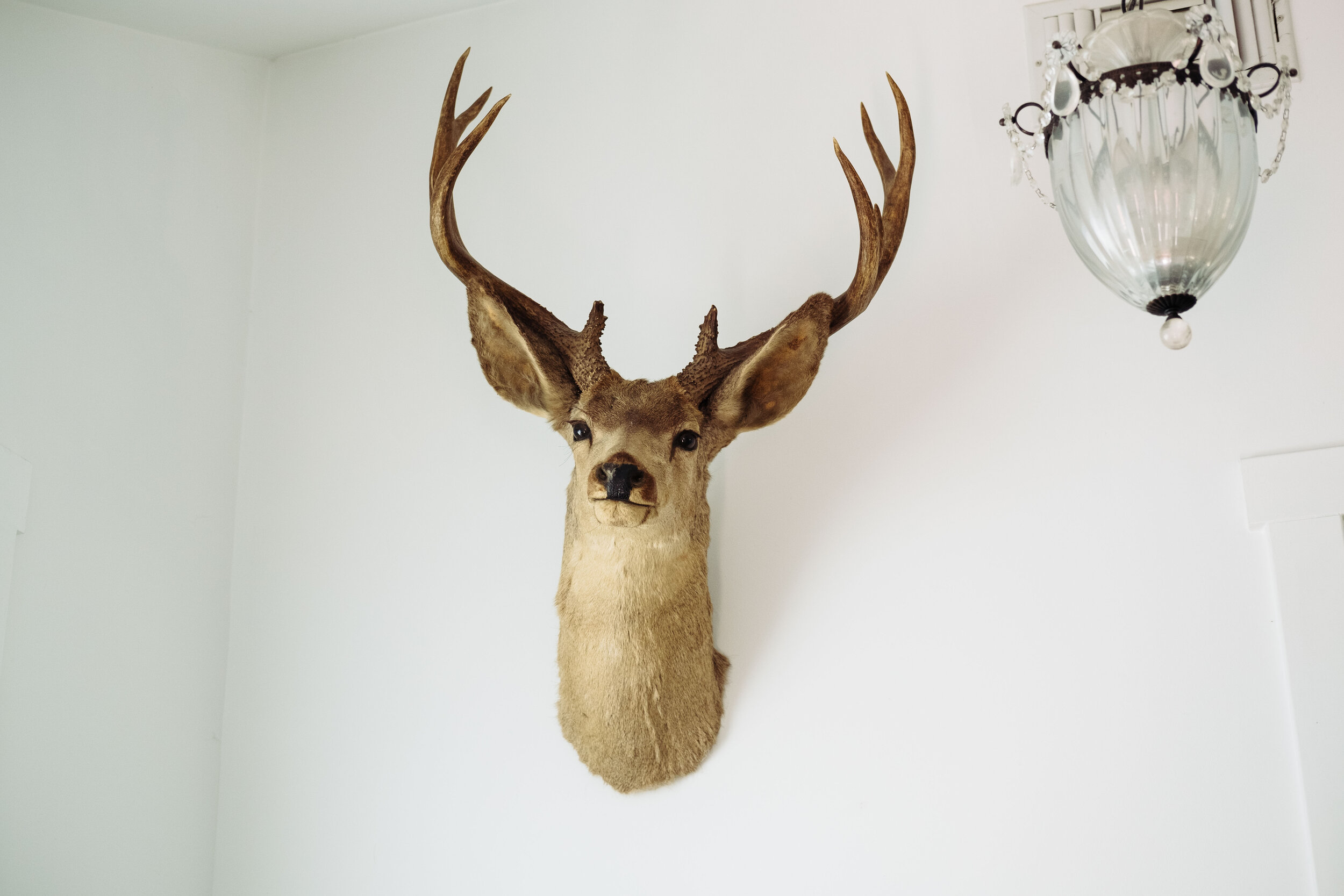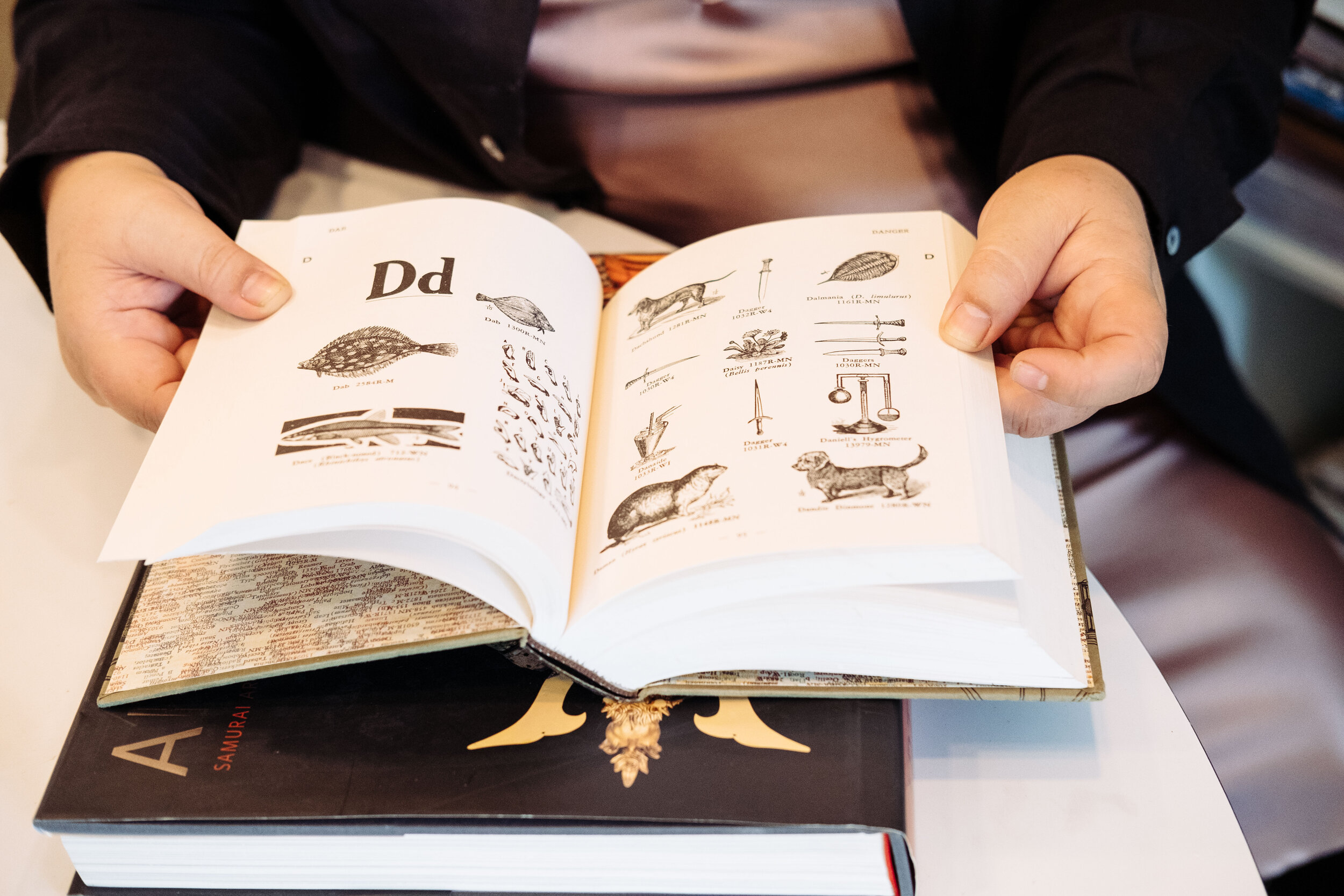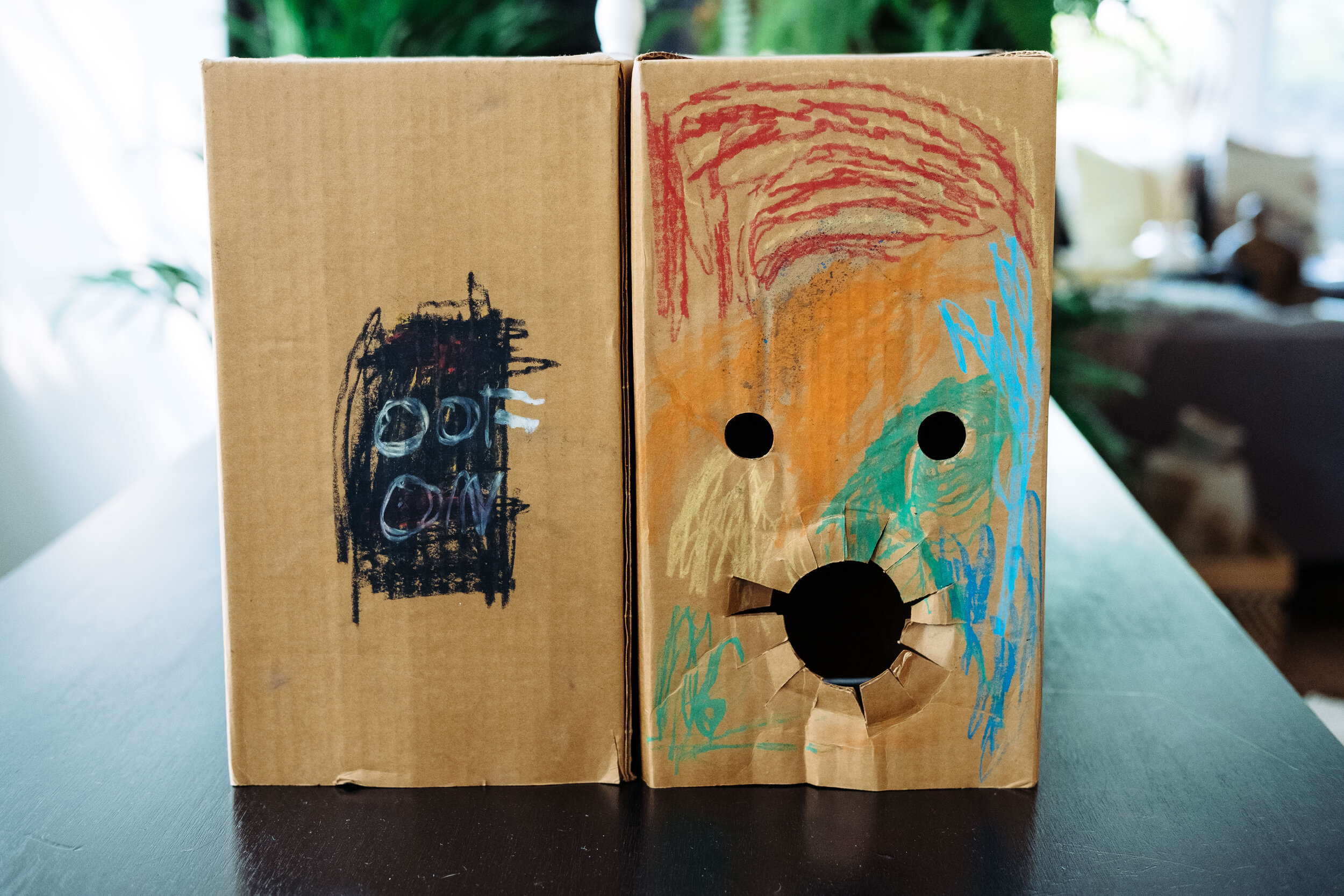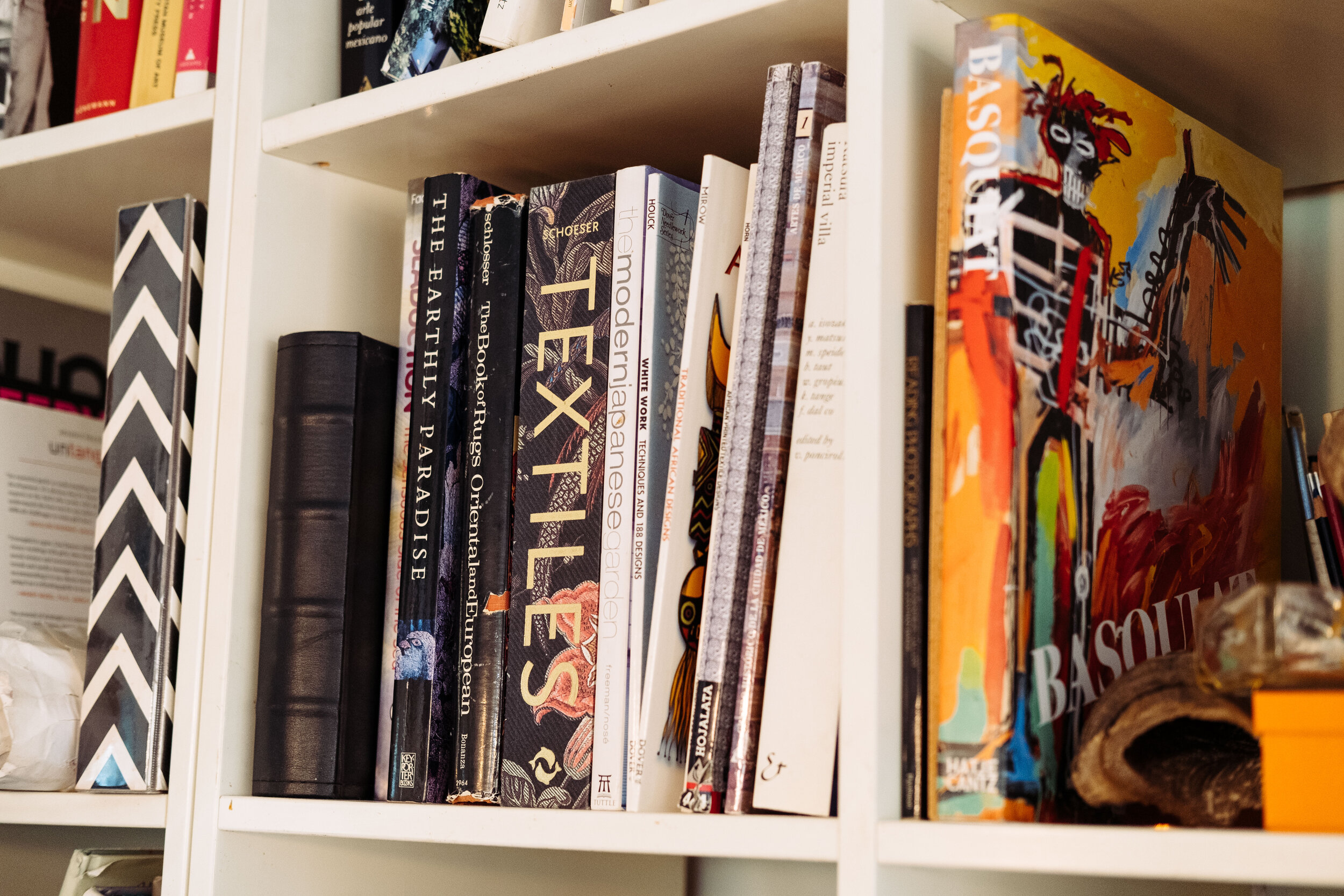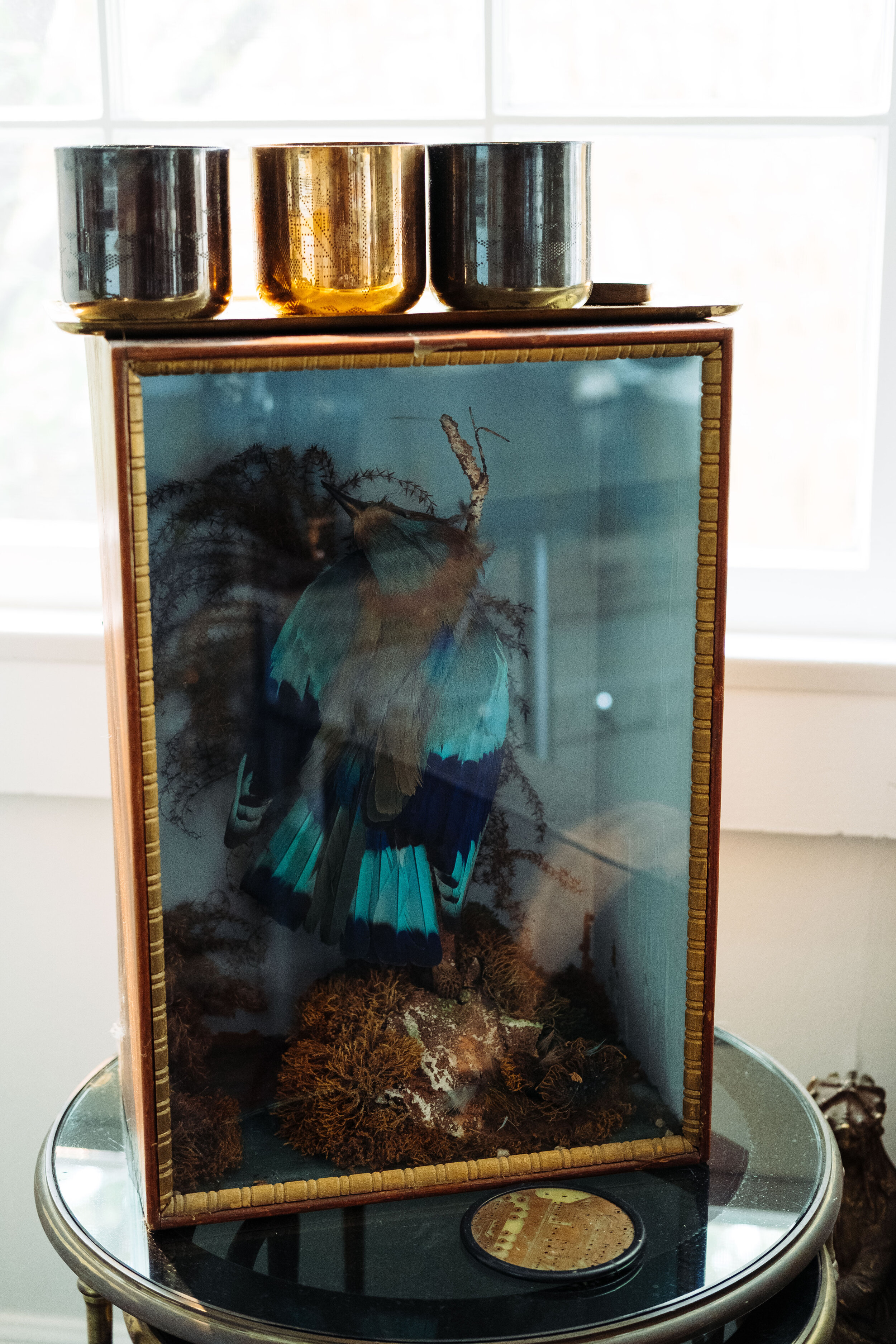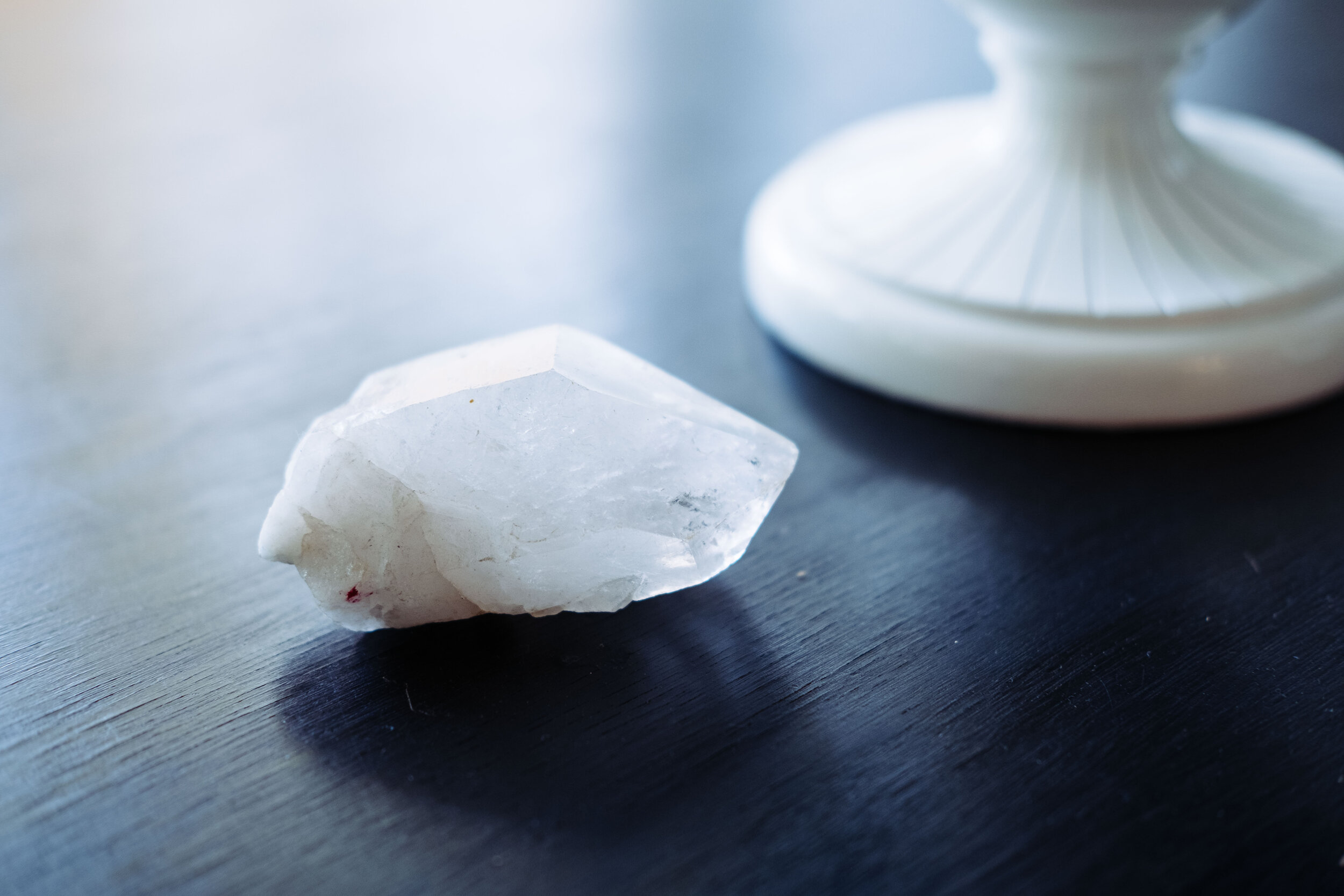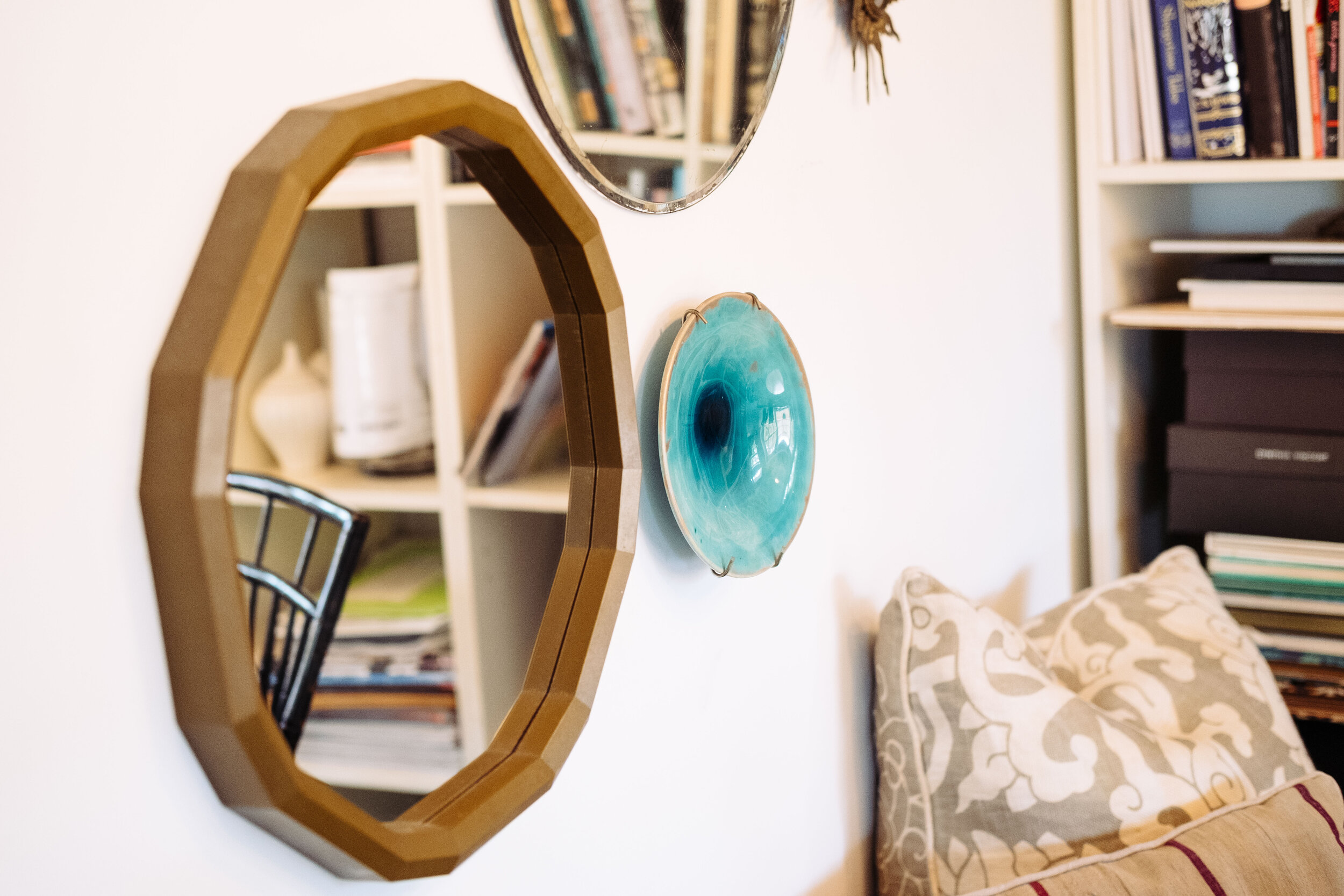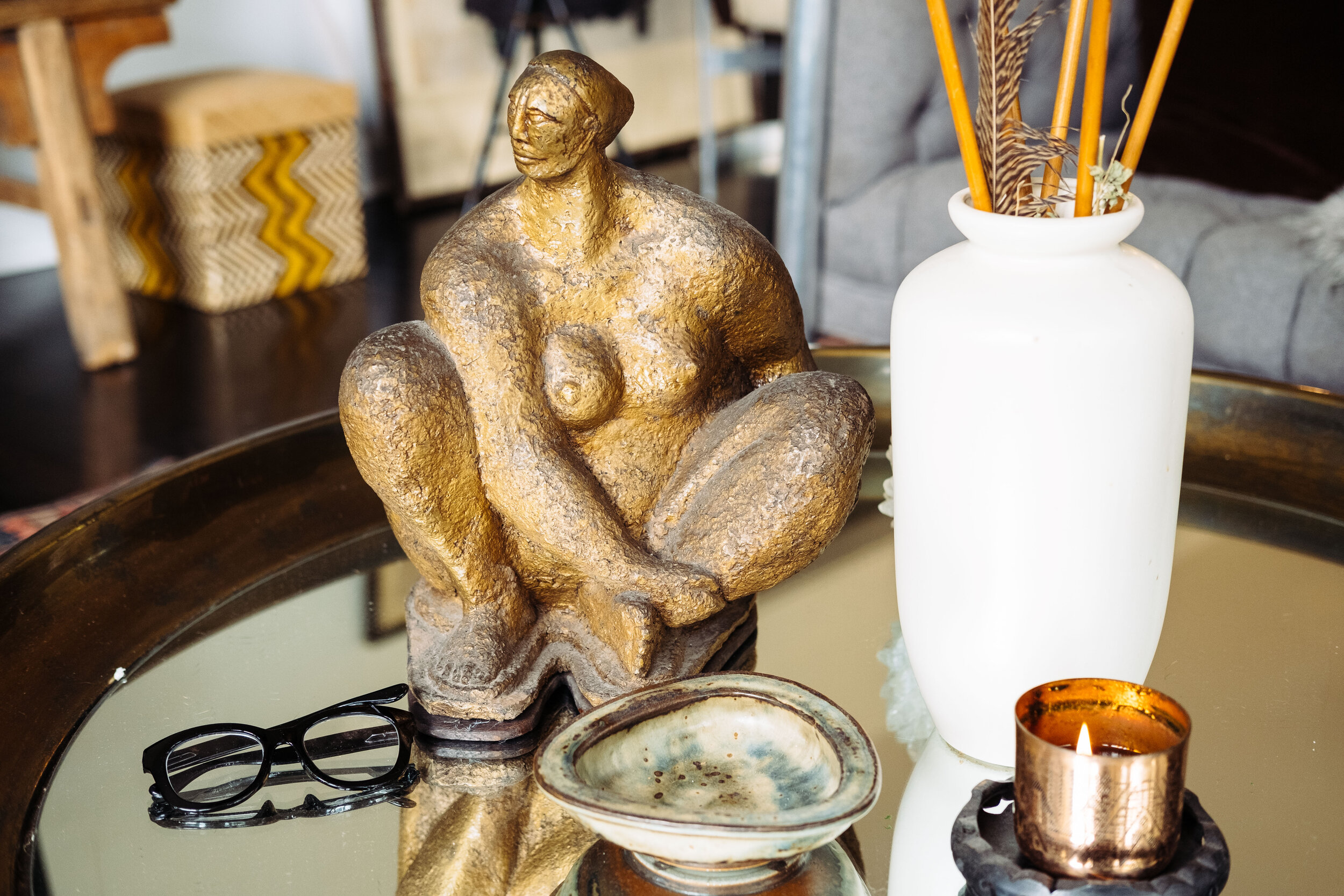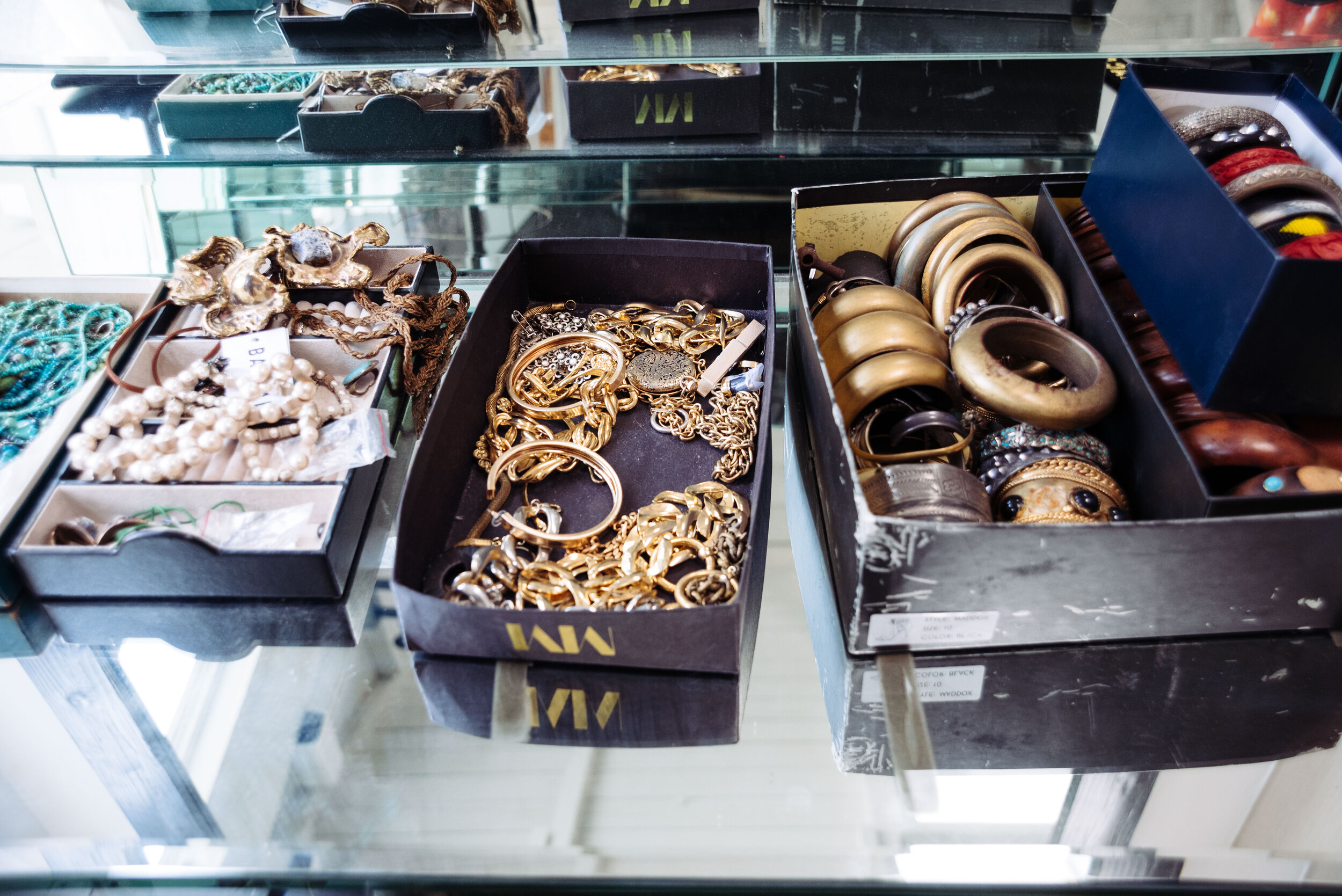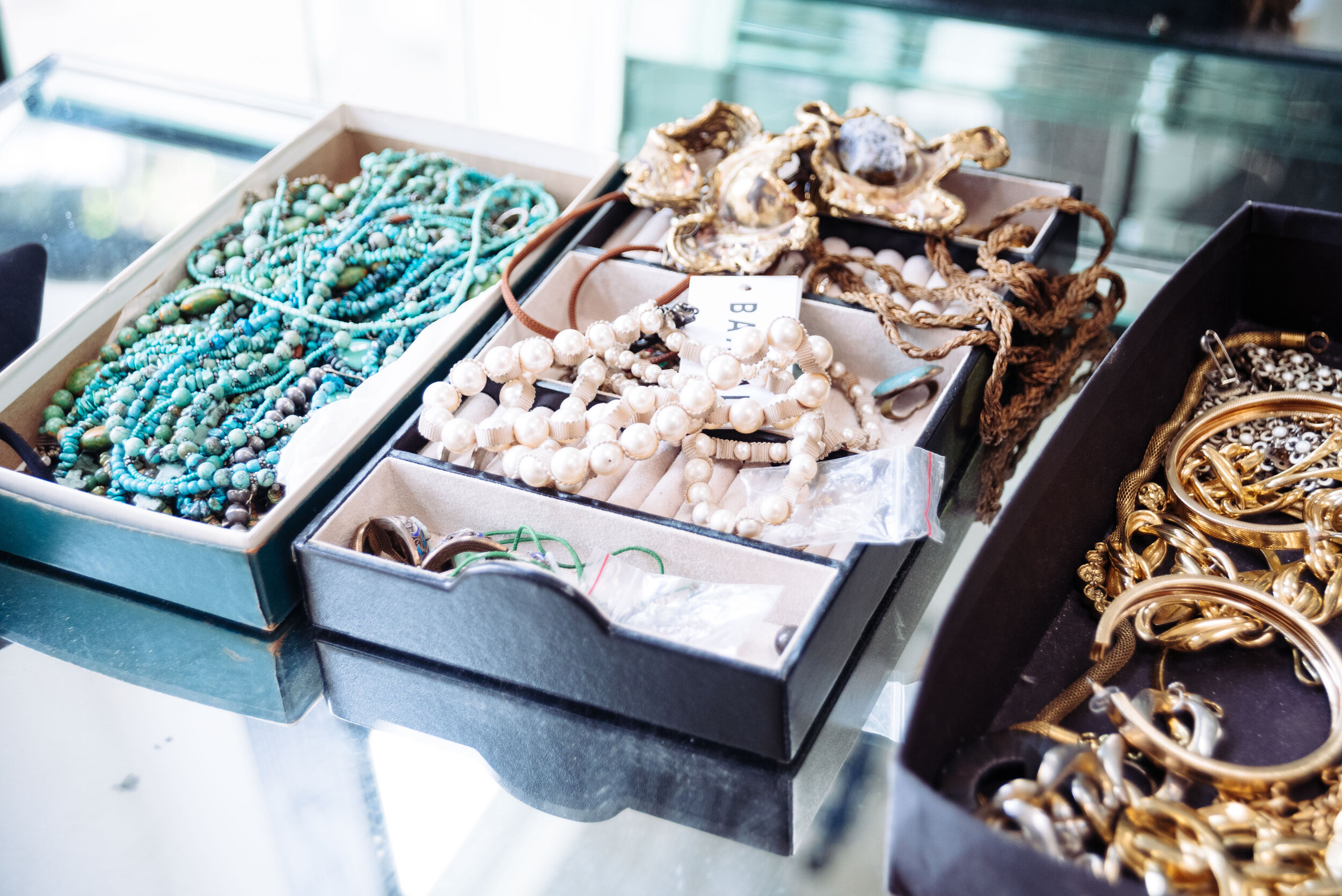Cynthia Vincent
The L.A.-based clothing designer addresses fat-phobia in fashion, her new line Baacal, and her focus on extended sizing.
By Lindzi Scharf
Photography by Birdie Thompson
Designer Cynthia Vincent has always been ahead of the curve. After launching three wildly successful brands (Vince, Twelfth Street by Cynthia Vincent, and St. Vincent) over the course of two decades, the Los Angeles-based creative most recently set her sights on Baacal, a sustainably-made contemporary clothing line focused on high-quality, fashion-forward designs exclusively available in sizes ten to twenty-two. Vincent’s direct-to-consumer label is a reflection of where she is in her life – both personally and professionally.
“My entire career, women past a size eight or size ten couldn’t find clothes,” Vincent says, seated on a grey couch inside her craftsman-style Eagle Rock home. “I’ve been a ten most of my life and I’m now an eighteen. I literally cannot find nice clothes.” Her years with Twelfth Street by Cynthia Vincent were no different and while she wanted to offer customers larger sizes, her then-partners pushed back.
“I couldn’t even fit into my own clothes; it was fucking ridiculous,” Vincent remembers. “With my partners at Twelfth Street, I had proposed doing extended sizing, but fourteen quickly went away and then twelve lasted maybe two years and then ten disappeared – and all of a sudden, I’m selling to Japan and I have to downsize to 00. But size ten was always the size that sold out first.”
Looking back on those years, Vincent says, “We were coming off of the waif [trend and the saying,] ‘You can never be too rich or too skinny.’ It was horrible and we’re suffering the repercussions of all that – of not accepting your body.” She pauses. “I could talk for hours about fat phobia and sizeism – especially in the fashion industry.”
This isn’t the first time Vincent has been a (clog-adorned) step ahead of her colleagues – whether it was her focus on a largely ignored population of fashion fans (whom she fought for long before “body positivity” was a term in the zeitgeist); the fact that she launched her fashion career in Los Angeles (when most designers were opting for New York); or her advocacy for sustainable behind-the-scenes business practices in the early aughts (as most consumers and designers still lacked any sense of eco-awareness).
Baacal, which Vincent launched in 2018, embodies all of the above. “Baacal is a niche that literally doesn’t exist,” she says, adding that eighty percent of her current company’s clothing is made in Los Angeles. “It’s better contemporary clothes that are investment pieces. That are wardrobe builders in your closet. That are sustainable and going to last for, hopefully, a lifetime if you care for it. It’s what any mindful company needs to be doing.”
SOUL SEARCHING
While Vincent’s ability to trend forecast is innate, there was a brief moment when she wasn’t sure she wanted to continue working in an industry that had fallen behind consumer habits.
“It’s an antiquated system,” Vincent says. “Shipping fall sweaters in June/July didn’t align with me anymore. [As trend forecaster Lidewij Edelkoort put it,] ‘Fashion is old fashioned.’ It had become old fashioned. I knew that department stores were in trouble. The analogy for me was ‘the head of the snake’s been cut off but no one has told the tail yet.’ I could see it and I didn’t know a way out.”
Vincent spent two years soul searching while consulting for other brands.
“I had gone through so much,” she admits. “There was a lot to unpack with that. It left me a little disillusioned.”
During that period, the designer recalls, “I didn’t want to make line after line after line; I didn’t want to get on that hamster wheel.”
She briefly dabbled with idea of creating a beautifully-designed, sustainable candle company, which seems fitting given that she was, at the time, burnt out.
“I really did ask myself, ‘Who needs one more piece of clothing?’” she says. “‘Do I need to put more clothes into this world? If I’m going to start something new, is that what I need to do? Maybe I should start an organization and help people.’ But when I thought about it, the customer I’m targeting and catering to [with Baacal] really does [have that need]. She hasn’t had a retail experience. She doesn’t have a lot of choices. She doesn’t have clothing that allows her to express herself. I’ve experienced it firsthand.”
YEARS EARLIER…
Before reaching a place of enlightenment, as only the school of hard knocks can teach, Vincent was once a wide-eyed fashion student at Los Angeles’ Otis Art Institute of Parsons School of Design. She attended during a summer break from high school, of which she recalls, “My parents were scared, like, ‘Are you sure this is what you want to do? It’s so cutthroat.’ That’s the only context they had.”
Despite her family’s lack of familiarity with or connection to the industry, Vincent’s path to fashion was inevitable. Growing up during the eighties in Claremont-La Verne, a suburb of Los Angeles, Vincent knew she wanted to pursue design at a young age. “I told my mom when I was six, but in the context of my Barbies,” she says, laughing. “I also used to sneak out of the kids section of the library and would go into the art section. Adrian was an A, so he was the first costumer slash designer that I discovered and then I discovered Chanel since she was under C.”
Vincent’s career kicked off when she was twenty-three with a gig as head designer for L.A. brand Harriet Selwyn. “I’ll never forget—I was at Barney’s for the ‘Unzipped’ party for Isaac Mizrahi,” Vincent says, referencing the then-designer’s 1995 documentary. “I was so proud of the work I had done for Harriet Selwyn. I [said to a colleague], ‘Come upstairs. I want to show you. ‘So we go up to the second floor and I’m like, ‘Look, I did all of this. This is my work.’ He’s flipping through it and he’s like, ‘I mean, it’s beautiful and all, but it doesn’t have your name on it.’”
The sentiment stuck with Vincent as she made moves toward her next venture. “Before I got the job at Harriet’s, I was working nights and weekends [on my own line],” she says. “I started St. Vincent in my home and I used to fit on my lunch hour from Harriet.”
When it came time to choose a name for her new company, Vincent remembered what her colleague had said during Mizrahi’s party. Following its 1993 launch, St. Vincent became a mainstay at then-fashion mecca Fred Segal. “I was selling merchandise downstairs and upstairs,” she says. “It was a wild ride.
METAMORPHOSIS
By 2002, four and a half years into the brand, Vincent decided to transform the company into—what has since become a household name—Vince. Of the decision, she explains, “I had run St. Vincent for a while and it was that classic story: ‘You start a company because you want to design and you end up not designing. You do everything else.’ I dabbled with investors and partners, but it didn’t work. Then somebody had put us – [Vince co-founders] Rea [Laccone] and Christopher [LaPolice] – together and we morphed St. Vincent into Vince.”
Now known for its knitwear, Vincent explains, “Vince was initially going to be a design-driven company. That was the mandate. That was what it was supposed to be. That was why I was interested in it, but it quickly was clear that it was going to be merchandise driven. Everyone was in Juicy [Couture] at the time. Everyone was wearing tracksuits. Our chic alternative was the cashmeres, the spa sets, the pants, the zips, and all the sweaters. It was a direction I believed in, but I also had all these new resources.”
Vincent says she was, creatively, already in a different state of mind and wanted to focus on printed, patterned dresses, which wouldn’t have been a fit for Vince’s established aesthetic. As a result, she parted ways with the brand after a year.
“Walking away from what would be, ultimately, a very successful company with my name on it was difficult,” she admits, explaining she left because “it wasn’t creative enough and we had different management styles.” Vincent says she also missed the flexibility of working solely for herself. “I had already had my own company for quite a number of years,” she says. “I had my autonomy. I had freedom and in that new scenario it was different. So I chose my quality of life and I decided to resign and walk away from it.”
THE OPPORTUNITY
Vincent intended to take time off for a year to explore India, but fashion executive Fern Mallis of New York Fashion Week called to say they were launching Los Angeles Fashion Week and that Mercedes-Benz wanted to sponsor her.
Vincent recalls telling Mallis, “Well, I just left Vince. Would you sponsor me?”
“Well, yeah,” Mallis responded. “You’re the reason I’m calling. Do you have a line?”
“Yes, I do,” Vincent remembers saying as she emphatically shakes her head.
“Then, yeah,” Mallis told her. “Absolutely. Fantastic.”
“So I changed my trip. I went for fourteen days, came back, put my first collection together [over two weeks], and showed at Mercedes-Benz Fashion Week.”
She used her personal savings to finance the project and named her new company Twelfth Street by Cynthia Vincent, an homage to the street she grew up on in Claremont-La Verne, California.
Launched in 2003, the bohemian-spirited line was immediately embraced by the likes of Beyoncé, Michelle Obama, Blake Lively, and Jessica Alba. Vincent ran the company for twelve years.
“After I had partners, I bought them all out,” she says. “I ran the company by myself for about a year and then I realized that I needed working capital. I needed a partner that could help me, so unfortunately, I picked private equity. That didn’t work out so well and they sold my brand. Twelfth Street was sold against my choice.”
Asked if it was hard having her name attached to yet another brand that she no longer operated, Vincent admits, “It was…” She pauses. “But then it went out of business. They didn’t do such a good job without me and I didn’t have to see it anymore. Frankly, what they put together wasn’t so good.”
Without the company’s DNA intact, the label survived just one year without her. “Business people think it’s a business like any other business,” Vincent says. “I was flat out told, ‘It’s a business like any other business. It doesn’t matter.’ It’s creatives versus financials. The fashion industry is unique in how it conducts business. But outside people and very successful business people, don’t believe you when they get into it. I’ve seen it time and time again.”
While five years have passed since the label – under The Gores Group – was shuttered, in an interesting turn of events, Vincent says Kellwood Apparel recently purchased the brand’s name. “I think they’re re-launching it,” she says. “I’ve made peace with it. It’s interesting that I didn’t get a phone call – if they liked it enough to buy the name. There’s value in the name, so that’s great. My hope is that the product is nice and that it’s not cringe-worthy because my name is on it.”
START-UP LIFE
Nowadays, Vincent remains focused on Baacal in addition to balancing life as a single mom to her fifteen-year-old daughter, Theanna. Mid-pandemic, the duo moved from their longtime home in Silver Lake to the Eagle Rock area, so that Theanna could be closer to the high school she wanted to attend. Vincent says the decision was in both of their best interests.
“I wanted to downsize and needed to downsize,” Vincent says, acknowledging she’s still navigating start-up life and home life – now that the two are so closely intertwined. “I’ll be honest, it’s been hard. But with our life changing, if I need to take a half a day off, I take a half a day off. If it’s going to be tomorrow, it’s going to be tomorrow. I have to consciously keep a balance currently. Previously, I had found a good place. When I had a thriving company and I had parted ways with my partners and I was on my own, it was important for me, and for everyone who worked with me, to have a quality of life.”
Of forcing balance earlier in her career, Vincent says, “As a single mom, I learned how to turn it off for the most part. Yes, emergencies happen, but in the morning, I was mom. After drop off, I was a creative director, designer, and business person, and then when she came home or if I picked her up from school, I was mom again. And I would work at night. I would let everyone know, ‘I’m available at six or seven,’ after she went to bed. I loved the flexibility. Being a boss allows you to have that.”
However, spearheading a start-up during a pandemic is newfound territory. “It’s such a weird time,” she admits. “I had a tremendous reaction [to Baacal’s launch] and I had this beautiful trajectory pre-pandemic. With the pandemic, it’s unpredictable. I’ve had to learn to be present and in the flow.”
The past year and a half has been, Vincent says, a combination of “absolute hell and absolute relaxation and joy.” She and her daughter bought a television. “We didn’t have a TV for five years,” she explains, noting they’ve been binge-watching shows like “Dear White People” amidst COVID chaos. “I’ll be honest, I watch far too much television now.”
Vincent also says that, at one point, she and her daughter had a “COVID scare” and “had to be quarantined from each other.” As a result, they’ve both grown quite a bit since 2020. “I’m extremely proud of my child and who she’s become and how she’s been able to weather it,” she says. “We were always close, but it’s different now.”
Admittedly, it’s been a stressful period, but Vincent says she feels a sense of gratitude. “You have no income,” Vincent says, “but I’m fine. I have a beautiful home. We have food. Some people don’t. I don’t know how, but I do. I mean, part of it is like, ‘I don’t even know how I’m standing, but I’m going to stand and I’m going to keep going.’”
During this time, she says she’s learned that she can’t do everything herself. “One of the biggest lessons is that I’ve had to ask for help,” she says. “I’ve never asked for help. I’ve never wanted help. Help is danger.” She’s since realized, “It takes more than [one person]. I can’t do this alone. I’m still learning how to do that, by the way, but it’s great.”
A TIME OF REFLECTION
After two decades in the fashion business, Vincent says, “My younger self would be surprised to know that I’m grey and starting a new company.” She laughs, then turns serious: “She would be surprised to know just how fleeting it all is. You can work so hard at something and, one day, it’s just gone.”
“I’ve had wins. I’ve had losses,” she continues. “Obviously, the failures are the hardest part.” She struggles to name what’s been the biggest challenge along the way. “I feel like I’m still going through it,” Vincent says. “Like [the previous challenges] don’t even matter, you know? It’s almost like right now is the most challenging. Here I am, again, diving into something [new]…. This is a whole new set of challenges that I’m learning, but that’s where part of the excitement and the joy is too. I don’t want to do the same thing over and over again.”
As for what lies ahead, Vincent says, “I’m firmly committed to making this a huge success. Baacal is probably the most personal for me. Being direct to consumer allows me to do what I believe in. All of these years and all of this experience has led me to this. All the iterations have been personal, but this company is absolutely a reflection of who I am right now.”
HOW SHE LIVES…
After spending the last fifteen years in Silver Lake, Vincent moved into a charming home in Eagle Rock. “I haven’t unpacked all of my boxes yet,” she says. “I’m a single mom; it’s just my daughter and me. This was a big move. I had a huge house, but we were always looking to downsize and she really wanted to go to [a particular high school in this area]. I looked and couldn’t find a place to buy. So we ended up renting this and it’s great.”
She and her daughter each had a few prerequisites for the move. “My daughter wanted an attic room,” Vincent says. “When I walked into this house, it had an attic. For a good three months, she put her room upstairs until it got too hot.” Vincent had her own criteria. “I needed a workspace,” she says. “I walked in the door and was like, ‘There’s a space in the back?’ It’s perfect.”
HER OFFICE
“I spend far too much time here,” Vincent says. “While my daughter is at school, I can be here. When she goes to bed, I come back and work.” While many people were forced to become acquainted with work-from-home life during the pandemic, it admittedly wasn’t much of an adjustment for Vincent. “I had been working from home for the last two years,” she says. “I turned the downstairs in my old house into a studio, so I was used to it.”
THE CHANDELIER
“It’s manifest destiny going west,” she jokes, pointing to the chandelier. “I didn’t like the chandelier that was in here, so those arrows are actually some that were in my old house. My father taught me archery when I was little in the backyard. He died and some of those are his arrows. It was my way of making something I don’t like into something I do.”
THE VINTAGE JEWELRY
Vincent is an avid vintage jewelry collector. “I’ve always loved beautiful things and I’ve collected jewelry my whole life,” she says, referencing a tray of antique pieces. “This is a tray that I usually bring out when we do photo shoots. When I travel, I purchase things I love.”
THE BRUTALIST PIECE
“I found this brutalist piece when I was traveling to Iceland twenty years ago,” she says. “I found this in a little store in Reykjavik. I used to wear this a lot. I was really into brutalist [architecture] for a while.”
THE EARRING
“I bought these on eBay,” she says, holding up another piece. “They’re one of my favorite earrings. The other is broken and I need to fix it, but I haven’t yet. I’ve actually always wanted to make something inspired by this.”
HER DAUGHTER’S POTTERY
“My daughter made this when she was three or four,” she says. “Someone gifted her this big block of clay. I didn’t know she had asked for it. This was one of the pieces she made with it.” Vincent becomes serious. “I said, ‘Did you learn how to do this in school?’ She’s like, ‘No, Mommy. In 1958, I was a famous potter.’ I still get chills. I was like, ‘A sculptor? A potter? Whaaat?’ I remember asking, ‘What was your name?’ Thinking I’m talking to whoever she’s channeling.”
Vincent admits she wasn’t sure how to react to the then-toddler. “I literally didn’t know what to do; I just let her do her thing and she made the entire brick [of clay],” Vincent says. “I asked her later about it, but it was never revisited. When they’re that young, time is fluid. She just never revisited it and I haven’t pushed it. I figure if she’s going to go back to it, she’ll go back to it on her own.” Vincent pauses. “She used to freak me out a lot when she was little.”
THE CANDLES
“I thought for a minute I was going to get out of fashion and start a candle line,” she explains. “I love scent. I had a little bit of experience with my friend Douglas Little who started D.L. & Company and now Heretic. I was exposed to it through him and then I realized how much I loved it.” She says she liked the idea that “it was about creating a product that would last; that I didn’t have reinvent myself every season; and that it was something that could have longevity.” She adds, “For me, jewelry, objects, tabletop, candles—I love home [goods].” The company would have been a combination of those categories. “I had the [candle] vessels made in Morocco and in Egypt. I had this idea that once the candle burnt out, they were these beautiful objects that you could use in your pantry or in your bathroom. I have q-tips and cotton balls in them and pencils. You could drill a whole in the bottom and they could be planters. I even toyed with the notion of refilling it—offering just the cylinders, so you could just refill your candle.”
WHAT’S IN A NAME
Vincent decided against using her name for her latest brand. “I wanted a Spanish surname [an homage to my heritage], but I didn’t want to put my name on it this time,” she says. “I wanted to separate myself from it. It was a conscious decision.” After what she calls “a wormhole of research,” she landed on Baacal, a nod to actress Lauren Bacall. “When she first started acting, she was asked to lose weight and she said no. She’s tiny. She refused.”
HER APPROACH
“I believe that it’s about quality, not quantity,” she says. “It’s about those right pieces that you need for your wardrobe. It’s not about having to present a new collection every season. The way in which we’ve consumed is not sustainable. For me, I want to only create pieces I really believe in that live in your closet for a really long time. I used to say, ‘I want to be a favorite in your closet.’ And I don’t think people really understood. Like—I want you to wear it multiple times. I want that idea of ‘You can only wear something once,’ to just be done with.”
HER UPBRINGING
Her eco-awareness stems from her childhood. “Even though I’m third generation, I have a deep connection with Mexico,” Vincent says, explaining she spent time each summer on her extended family’s ranch and farm. “My mom is American and she was born here, but her father died when she was a baby, so my grandmother took her back to Mexico. The way in which they lived there – you just didn’t waste anything. You were mindful of the earth. I was exposed to that every summer. It’s always been instilled in me from my family.”
SUSTAINABLE PRACTICES
“At Twelfth Street, I tried [to be sustainable],” Vincent says. “There was a lot of clean waste that would happen [there]. It would kill me that you’d go to the cutters and they would dump [everything]… Have you ever seen a cut on the table? When you cut a dress, each of these pieces is a pattern piece; so it’s like a puzzle and it gets cut on a table and all the layers of fabric is negative space. It’s tons of clean waste and they would just dump it. I would go and it would be piled into a dumpster. I was like, ‘This is insane.’ So I found art teachers and organizations that would take the clean waste because I didn’t want my stuff going in a landfill. I was doing that ten years ago because you can’t ignore it.”
THE INDUSTRY
She’s happy to see the industry shifting toward a more sustainable and inclusive approach. “It needed to change,” she says. “There’s an incredible amount of waste [in fashion]. … It’s nice to see [things moving in the right direction], but we have a long way to go. Fashion had become this disposable commodity and it just isn’t sustainable.”
Vincent acknowledges that it’s a more difficult path, but says that it’s the only path forward. “It’s cumbersome and expensive,” she admits. “Even in my experience, it’s hard to be sustainable. It’s much easier to throw that plastic bag away, but we can’t. We have to be mindful. I don’t even want the plastic bag, but what do you do if you’re shipping garments to somebody in a box and it’s raining where it’s going to be shipped to? I actually check the weather before we pack, so that we ship the least amount of plastic possible.”
HER VINTAGE CLOTHING COLLECTION
“I haven’t bought anything in the last two years,” she says, standing by a clothing rack that showcases her vast archive of vintage clothing. “I’ve been slowly selling off my archive and honing down the pieces I love.” She explains that she used to scour the world looking for unique pieces. “I found them anywhere and everywhere,” she says. “Anytime I traveled, I’d always go to a vintage store. In the past, [before the pandemic], my daughter and I would take one trip [every year]. We’d do a plane, train, and automobile [journey]. She loves thrifting, which is amazing. I’m glad she doesn’t hate it because sometimes kids want the opposite. She gets totally different things, but we enjoy it. I’ve been to thrift stores in Wyoming, Colorado, South Dakota, Florida – you name it.”
A VINTAGE FIND
“This is one of my favorite more contemporary pieces,” Vincent says. “It’s from the mid-seventies.” In addition to hitting up vintage stores, she scours the internet for pieces. “I love the hunt. I love eBay, 1stDibs, Blackman/Cruz, The Way We Wore, Retroblades, and Coveted by Christos. I’m constantly looking. I had such a bad habit. I would tell people, ‘Tell me what you’re looking for and I’ll find it for you,’ because I enjoyed doing it.”
A CHILDREN’S VINTAGE PIECE
“I actually dressed my daughter in this,” Vincent says, holding up a white vintage dress. “I love the organdy and the embroidery. It’s such an inspiring piece for me. This would be such a great dress for an adult, right?” Asked if her daughter ever steals items from her wardrobe, Vincent says, “She doesn’t need to steal anything. There’s so much. I try to get rid of as much as possible. She appreciates some of the old CV stuff. She’s into the aughts right now.” Vincent laughs. “That’s not my favorite time period. It was horrible. All those sheer dresses over pants? It looked terrible. I hated it in the time. I couldn’t believe how people dressed then.”
THE QUIRKY KAFTAN
“I have a huge kaftan collection,” she says. “This one is just kooky and cool. Isn’t it funny?”
THE VINTAGE SUIT
“This is from the forties,” Vincent says. “I found this in high school in a thrift store and I still have it. It’s Irene for Bullocks-Wilshire.” When Vincent first arrived in Los Angeles as a high school student attending fashion school, she would often go to the then-famous luxury department store. “I would go in there with the old ladies and try on all the Chanel and have lunch. Irene was a working designer. She was an inspiration to me. It was like, ‘Oh, this is this job. I can be a designer.’ This was way before Project Runway or anyone knew what fashion design was.”
OBLIQUE STRATEGIES
“This was developed by Brian Eno and his friend Peter Schmidt back in the seventies,” she says, holding up a set of Oblique Strategies cards. “It’s a hard thing to find, but they republished it [more recently]. David Bowie used it when he did the Low album.” She explains that it’s a method for promoting creativity. “You pick a card,” she says, offering up the deck. “The idea is that you follow the cards… So if the cards said to do something, you actually do it.” She picks one from the deck and reads it aloud: “Mine says, ‘Tidy up.’ Interesting…” she chuckles, “because I just did.”
OBLIQUE STRATEGIES: PART TWO
“What does yours say?” she asks. Her assistant holds one up that reads, “What would your closest friend do?” Others in the deck read: “Remove ambiguities and convert to specifics;” “Give way to your worst impulse;” “Make a sudden, destructive, unpredictable action.” Vincent recently incorporated the cards into her daily routine. “It really got me unstuck the other day,” she says. “It said, ‘Throw away the recipe.’ We started laughing. I was like, ‘That’s exactly what I have to do.’ … We’re a bootstrapping start-up, so I constantly have to ask myself, ‘What’s the most important thing for me to do right now to move forward? Move this business forward. Let the bills go. Focus on the most important thing.’ Because, you know, I like to do all the fun things first.”
THE CURRENT COLLECTION
“This is all of what’s in store online [at Baacal.com],” she says, pointing to a rack of fall clothing. “This is my working rack and then this is what’s coming in as we know what’s hitting and fitting. I believe in being a little more in-season versus the old fashion calendar.”
THE DESIGNS
“Sometimes I feel like my line looks a little schizophrenic,” she jokes, explaining her designs stem from a place of practicality. “We have so many facets of our lives.”
THE MIRRORED KAFTAN
“I believe a woman should have an amazing caftan in her wardrobe,” Vincent says, clad in one of her own designs paired with a unitard. “I actually started out with a mirrored caftan because this is something you would keep forever. You don’t have to treat it so preciously. Wear it to the beach. Wear it poolside. Wear it for a night out. You can wear it black tie.”
THE TIE-NECK BLOUSE
“This is my Marion blouse,” she says. “This is something I designed when I first launched Baacal. This was one of the first pieces. I did it in eggplant and black and some classic colors. Now I’m offering it in fuchsia.” She holds up another piece. “I also did the dress version. I fit it in a way that you can wear it from front-to-back or back-to-front. You can tie it different ways. You can leave it untied. It’s this idea of multiple wears in these investment pieces that build your wardrobe.” Vincent’s fashion philosophy is that consumers should be offered, she says, “an item of the season” as well as “pieces that you need forever in your wardrobe.” She explains, “If you bought a classic blouse in black last year, now you can pick up a beautiful new color.”
THE JONI DRESS
“This is the Joni dress,” she says, sharing that its name is a nod to singer and icon Joni Mitchell. “I fell in love with this print. I thought it was so incredible. This is my bestseller right now. It sold out on the second reorder. Because it did, I’m developing it in new colors. It’s that ‘wear-it-forever’ dress. You can have it in your closet for years. I try to source a lot of vintage fabrics or stock fabrics.” She explains that the designs she’s holding are sold-out samples that are no longer available as a result of her eco-approach. “It’s kind of sad that they’re gone when they’re gone, but it’s great for the customer. She has something special that only twenty or forty people have – depending on how many yards [of fabric] I found.”
THE COAT-SWEATER COMBO
“This is a coat and a sweater I did for fall,” she says. “It’s my classic three-quarter coat, which is based on an old camel men’s coat I used to wear. I modified it to fit. It’s slightly oversized and has that slight eighties shoulder pad. But it’s also classic enough that you can wear it next season. I have old fans and clients that wear the oversized stuff in the smallest size.”
A PRINT OF THE MOMENT
“Do you want to see the fabrics?” Vincent asks. “This is my newest vintage find. I’m really into this print. It’s getting more and more challenging [to find deadstock fabrics], but I look anywhere and everywhere. I use my old sources. I call them on the phone. I ask them to send me photos. I shop downtown at Ragfinders of California. I do make some things in China and make sure it’s all deadstock there because it’s okay. You can be using deadstock – but if you’re flying it all over the world, it’s not sustainable.”
THE MOOD BOARD
“This is for an upcoming photo shoot,” she says, referencing a mood board in her design studio. “This is a print I’m working on right now. It’s on there because I need to look at it. I need to live with it for a minute, so I always put it up. … Then this board will come down as soon as I [complete that project] and then you’ll see a whole new board.”
HER DOG
“Is she not posing?” Vincent says, as her pup Niko cheeses for the camera. “She’s just a big ‘old ham. She wants to be in all the shots. She does this at every single photo shoot. You want to dance? Okay, show off! She’s pretty delightful.”
THE DEER
Vincent picks up an object. “But dear…” she deadpans, then explains: “I’m an avid collector of taxidermy. This was in my old home. When you came down the stairs, it was always the conversation piece. I would always make a joke and it took people a minute [to get it]. I’ve been collecting for thirty years.”
A LOVE OF TAXIDERMY
“I know some people find taxidermy a little offensive,” says Vincent, explaining it was a part of her upbringing. “My family and I would go to Mexico every summer. I’m Mexican. We would spend one to three months at my grandmother’s and there was a cousin who hunted on the farm. He took one of their finds to a taxidermist and I remember being intrigued by it. He actually gave me a coyote skin when I was young and I remember bringing that back. There’s this morbid curiosity when you’re young, but I also appreciated how beautiful they were.”
THE ORNATE HEADDRESS
“I wanted something beautiful to put into a case in a specific place in my old house,” she says, holding up an antique Thai dancers headdress from the twenties that she found on 1stDibs. “I never did it, so I just used to wear it.”
THE BOOK NOOK
“I used to have floor-to-ceiling, wall-to-wall bookshelves [in my old home], so I put these few in the new house for all my books,” Vincent explains. “This is my area to sit and do my research.”
HER FAVORITE TOMES
“I love this book,” she says. “It’s all about Japanese armor and all the warriors from different dynasties.” Another favorite is a Webster Pictorial on birds. “I’m obsessed with birds,” she says. “I love their feathers. This is an especially great book. It’s a dictionary, but it’s all visual.”
THE NOSTALGIA
A few cardboard creations from her daughter’s childhood are on display. “I don’t remember when she made them,” Vincent says. “I ordered Thanksgiving dinner and this was how the food arrived. She made these masks out of them. I’ve kept these forever.”
THE RENEGADE ANGELENO
Vincent has always been a bit of a renegade – right down to the fact that she chose to kick off her career in Los Angeles versus the fashion industry standard of New York. “L.A. is an easier city,” she says. “Or it was. I don’t think it is so much anymore, but it was a much easier city to start a company; to be an independent, young designer and start a company. Everything was in walking distance downtown. My cutter was two doors down. My sewers were just around the corner. It was a much more nimble, friendly environment back then. So [I chose L.A. for] practical reasons. I did contemplate New York. I did think, ‘Is that really where I need to be?’ Yes, I probably would have done better press-wise and networking-wise if I had moved to New York, but that wasn’t that important to me. My quality of life was more important. I love where I live.”







